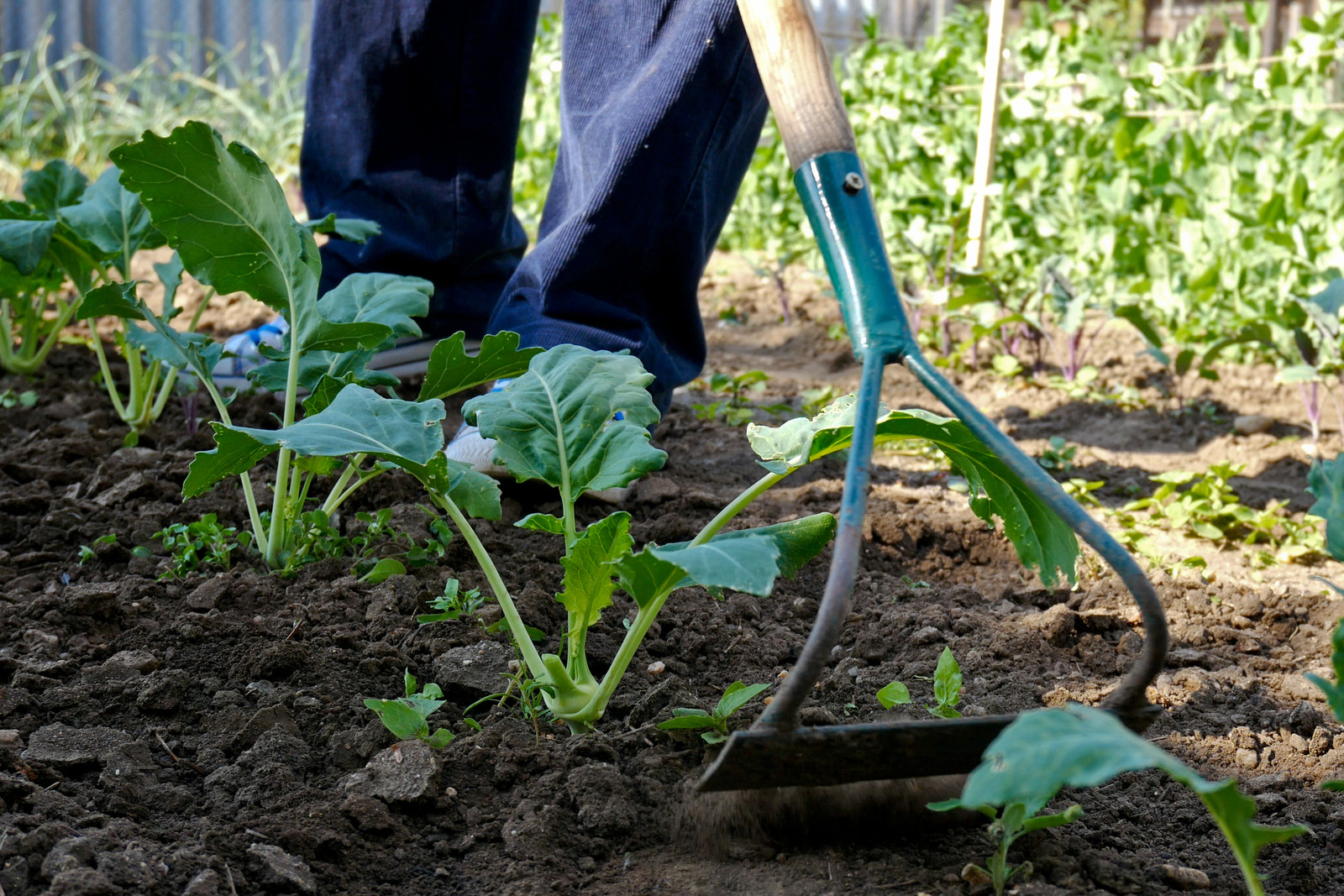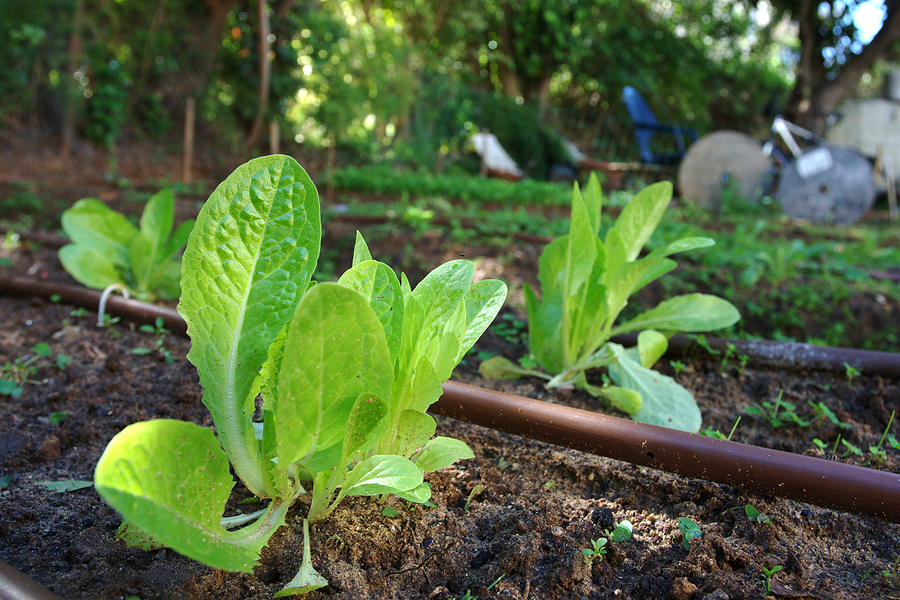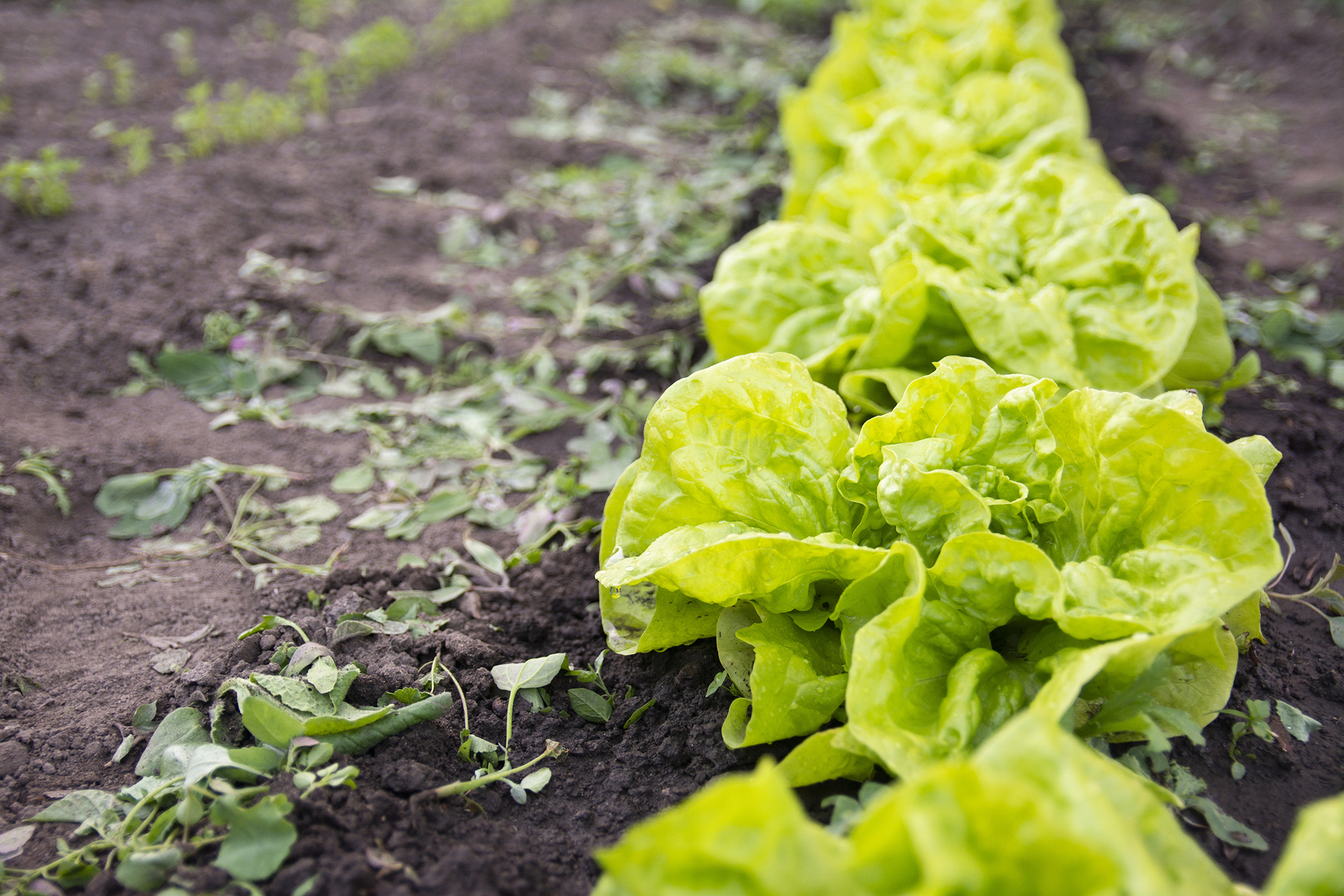A weed is any plant that grows in the garden that you do not want.
Weeds steal water and nutrients from vegetable crops reducing yield. Weeds compete with vegetables for sun and provide a refuge for pests and diseases.
The best strategy for weed control is to prevent weeds from germinating and eradicate those that do.
Integrated weed management (IWM) is the holistic approach to weed growth and suppression in the garden. IWM recognizes that the complete eradication of all weeds from the garden now and for all time is not only impossible but probably not desirable.
Organic Weed Control at Amazon
- Monterey Vegetable Pre-Emergent Weed Control
- Homietina Heavy Duty Weed Barrier Fabric 4×300-feet
- Preen Natural Vegetable Garden Weed Preventer
- Green Gobbler 20% Vinegar Weed and Grass Killer
- WeedGuard Plus Biodegradable Paper Weed Barrier

What is a weed
A weed is a plant growing any place in the garden where you don’t want it to grow; a weed is a pest plant.
Most weed species are fast-growing and abundant re-seeders. Weeds—like flowers and vegetables—may be annuals, biennials, or perennials. Annual weeds germinate, grow, and re-seed in one season; biennials germinate and grow the first year and re-seed the second year. Perennial weeds live more than two years and commonly reproduce not only by seed but by roots, stems, and stolons. Annual and biennial weeds are generally shallow-rooted and can be slowed if not allowed to flower and set seed. Perennial weeds are deep or long-rooted and can be especially difficult to be rid of.
Two types of weeds: annuals and perennials
There are two types of weeds: annuals and perennials. Annuals complete their cycle of growth–from seeds to mature, seed-producing plants within a few months; once they flower and produce seeds, they die. Annual weeds include knotweed, ragweed, and chickweed. Some annuals can produce several generations in a single growing season.
Perennial weeds can be herbaceous or woody. Herbaceous weeds have soft stems; they store food in fleshy roots, tubers, or bulbs. They can survive winter–usually going dormant, and resume growth the following spring. Perennial weeds usually have deep roots which must be totally removed to control. Perennial weeds include curly dock and crabgrass. Woody perennial weeds store most of their wood in woody stems; they commonly have simple root systems and are comparatively easy to control. Poison ivy and poison oak are woody perennial weeds.

Weed management
Weed control is an ongoing process. Weeds are easy to control when they are young. They are more difficult to control as they grow and establish roots. They can become a major problem if allowed to flower and drop seeds–ensuring future generations. The best way to control weeds is to remove them young and often. It is best to remove weeds roots and all. Remove young weeds by hand or by shallow cultivation with a hoe.
Keeping the weed population to a minimum is important not only for overall garden appearance but also to ensure that the vegetables and ornamental plants thrive. Here are some suggestions for dealing with weeds:
• Weed tolerance. You will never rid your garden of all weeds. Decide how many weeds you can tolerate and how you can turn their presence to your advantage. Know the problem: What weed species are growing in your garden? (Identify them and make a list. Know their life cycles and habits.) How aggressive are they growing and spreading? Where are they growing? How much damage are they likely to cause other plants? After you answer these questions, you can begin to manage weeds, not let them manage you.
• Habitat modification. Weeds can be managed with the modification of the growing conditions which allow them to thrive—habitat modification. Where weeds thrive you can limit the availability of water, nutrients, and sunlight. You don’t have to nurture weeds; you can manage them.
• Irrigation. Drip irrigation or directed watering of vegetables will eliminate the widespread availability of moisture to weeds. Avoid overhead watering which spreads moisture across the garden—not just where it is needed. Use a drip irrigation system that places water in the root zones of edible plants. There will be little moisture left over for weeds.
• Grow on mounds. If you don’t use drip irrigation, plant vegetables on raised soil mounds, and irrigate via furrows between mounds. You can easily cultivate furrows and the edges of mounds to be rid of weeds growing close to crops.
• Fertilizers. The application of fertilizers or plant nutrients around crops rather than across a garden bed will limit the nutrients available to weeds. Sidedress crops with compost or fertilizers—place fertilizer close to crop roots and stems. Avoid using more nitrogen than necessary; many grassy weed species thrive on nitrogen.
• Sunlight. Limit sunlight available to weeds by closely planting crops and covering unplanted soil with mulch. Intensive planting allows weeds to be plucked or cultivated out of the garden early on. As intensively planted crops mature they will touch leaves and shade out new weeds.
• Mulch. Weed seeds find it difficult to germinate if mulch keeps sunlight from reaching the soil. Apply light mulch such as straw 6 inches deep; apply heavy mulch such as leafmold 3 inches deep.
• Focus. Focus your weeding efforts on weeds that exceed your tolerance level. Suppress weeds that threaten vegetables and other cultivated plants rather than all of the weeds in the garden.

Organic weed controls
• Remove weeds and their roots as soon as they appear. Pull weed seedlings by hand or chop them off just below the soil surface with a hoe. Use a garden knife or a screwdriver to upend deep-rooted weeds. Frequent weeding sessions will prevent weeds from becoming established.
• Smother weeds with a deep layer of mulch. This is most effective against weed seedlings. Use weed-free straw, about 8 inches, or use grass clippings, about 2 inches. Weeds that poke through mulch are easy to pull by hand. Newspaper and cardboard also make excellent mulch; lay down four or five layers of newsprint or a thick layer of cardboard. (Use newspaper or cardboard that does not contain colored print or a wax coating.) Black plastic can be used to deprive weeds of sunlight and smother them as well, but plastic is best used in the cool time of the year so as not to overheat the soil during the growing season.
• Never let weeds flower. If weeds begin to flower, pick off the flowers immediately and dispose of them. Don’t let weed flowers form seeds. Place weed flowers and seed heads in the trash, not in the compost pile.
• Spray weeds with vinegar. The high acid content of vinegar (try pickling vinegar) will slow weeds. Several applications of vinegar may be needed to totally eradicate some weeds.
• Scald weeds with boiling water. This is effective against perennial weeds but may require several applications. After you apply a stream of scalding water to a weed, immediately cover it with newspaper or black plastic to be sure no light reaches the weed. The roots of many perennial weeds can survive a round or two of hot water and even herbicides–be persistent in your efforts to kill perennial weeds.
• Improve the soil. Many weeds thrive where the soil is organically imbalanced—low in some minerals and an excess of others. Add aged compost to planting beds regularly to keep the soil fertile, and an even balance of major and minor nutrients necessary for plant growth. Be sure that you add only weed-seed-free compost to your garden beds.
• Plant vegetables intensively—meaning space plants to that their leaves just touch at maturity. Intensive planting allows for more crop plants in a small space while the weeds below are deprived of sun and shaded out by the canopy of maturing vegetables.
• Avoid rototilling once vegetable garden beds are established. Weed seeds can sit dormant deep in the soil for years just waiting for exposure to light and moisture. Sheet composting—adding a layer of compost across the vegetable garden twice a year—is the best way to feed the garden and avoid turning up buried weed seeds.
Common vegetable garden weeds
Click on these common weeds to get a description and organic controls:
Bindweed – Black Nightshade – Canada Thistle – Chickweed – Crabgrass – Curly Dock – Dandelion – Foxtail – Knotweed – Morning Glory – Nutsedge – Oxalis – Plantain – Purslane – Poison Ivy – Poison Oak –Ragweed – Shepherd’s Purse – Stinging Nettle – Wild Garlic
The worst weeds
Here are common garden weeds that are almost always problematic:
Narrowleaf weeds
- Annual bluegrass (Poa annua L.): winter annual; bunchgrass. Tufted, light green, usually found in cool, moist areas. Control by reducing soil compaction and improving water drainage. Hoe and apply mulch. Use a pre-emergent herbicide in the fall.
- Bermudagrass (Cynodon dactylon L.): perennial, prostrate, and spreading. Often used as a lawn; spreads via rhizomes and stolons.
- Crabgrass (Digitaria spp.): summer annual; spreads and roots at nodes. Green to yellow-green; two species one hairy and large the other smooth; control with pre-emergent herbicide applied in late winter.
- Curly dock (Rumex crispus L.): perennial. Grow large thick taproot; wavy leaves grow from a rosette. Control by removing taproot; apply a pre-emergent herbicide in late winter.
- Dallisgrass (Paspalum dilatatum): perennial, bunch-type growth, spreading from the crown. Closely jointed rhizomes; sparsely branched seed heads; dormant in winter. Control by removing clumps; apply pre-emergent in late winter.
- Italian ryegrass (Lolium multiflorum): winter annual bunchgrass. Glossy leaves; long seed stalks with spikelets attached on alternate sides. Control by hoeing and mulch; apply pre-emergent in fall.
- Kikuyu grass (Pennisetum clandestinum): perennial, prostrate habit. Thick rhizomes and stolen; similar to bermudagrass but coarser. Control with a pre-or post-emergent herbicide.
- Spotted spurge (Chamaesyce maculata): summer annual. Red spots in the upper center of leaves; milky sap. Control by mulching; apply pre-emergent or post-emergent herbicide.
- Wild barley (Hordeum leporinum): winter annual bunchgrass. Dull green, smooth leaves. Control by hoeing and mulching. Apply a pre-emergent in the fall.
- Yellow foxtail (Setaria glauca): summer annual bunchgrass. Flat leaves some in a spiral twist; dense, erect spikelets. Control by mulch and hoeing; apply pre-emergent in late winter.
- Yellow nutsedge (Cyperus escultentus): perennial (dormant in winter). Spreads by tubers; can create 400 new tubers each year. Control by removing plants often applying post-emergent herbicide.
Broadleaf weeds
- Birdseye speedwell (Veronica persica L): winter annual. Roundish leaves and small blue flowers with white centers. Control by mulching and hoeing. Apply pre-emergent herbicide.
- Bristly oxtongue (Picris echioides)L biennial, prostrate habit, Yellow flower heads; leaves to 6 inches, hairy and rough. Control by mulching and hoeing.
- Cheeseweeds (Malva parviflora): winter annual or biennial. Large round leaves with red spots at the base of the blade. Apply preemergent herbicide.
- Creeping woodsorrel (Oxalis corniculata): perennial with running roots. Leaves resemble clover; ejects seeds to 10 feet. Control with preemergent herbicide.
- Dandelion (Taraxacum officinal): perennial. Grow large thick taproots. Pull or hoe; remove all pieces of the taproot.
- English daisy (Bellis perennis): perennial, low grower. White or pink flowers. Dig out plants; apply post-emergent.
- Field bindweed (Convolvulus arvensis): perennial. Deep-rooted; twining stems; white or pink flowers similar to morning glory. Cultivate repeatedly to starve roots. Apply post-emergent herbicide.
- Knotweed (Polygonum aviculare): summer annual. Forms a circular mat. Hoe and remove by cultivation.
- Plantain (Plantago spp.): perennial. Buckthorn stalks are long. Hoe or pull plant; mulch; apply post-emergent.
- Purslane (Portulaca oleraceae): summer annual; prostrate habit. fleshy stems and leaves; pale yellow flowers. Hoe or pull plants.
Benefits of some weeds
Weeds can serve a purpose; here are the benefits weeds offer:
• Soil fertility and water holding capacity. Perennial weeds such as thistles, nightshades, and pigweeds are deep-rooted and penetrate the subsoil. Root penetration breaks up the soil and allows water and nutrients to move up and down through the soil. Moisture seeps down and phosphorous and potassium are drawn to the surface for use by other plants.
• Habitat for beneficial insects. Weeds in the sunflower (Asteraceae), parsley (Apiaceae), and mustard (Cruciferae) families are nectar sources for beneficial insects. Most weed flowers are shallow-throated making their pollen and nectar easily available to beneficial insects.
• Trap crops. A border or row of weeds along a garden will attract pest insects that otherwise might concentrate in the garden and harm crops. You can encourage weeds that attract pest insects. Keep weeds lush and irrigated to attract insects, but cut back the top of weeds before they flower and set seed. Monitor weedy trap crops for insect eggs and pest insect larvae; handpick or spray pest insects in trap crops before they move into the garden.
• Soil protection. Low-growing weeds that compete poorly with vegetables can protect the soil from drying out. As long as weeds are not competing with crops for moisture and nutrients, they can hold the soil in place and keep the sun from baking the soil.
Useful weeds
Some plants–commonly weedy–have good qualities. Here are some weeds that can be useful:
- Blackberry (Rubus spp.): edible fruit
- Cattail (Typha spp.): roots and young shoots are edible
- Chicory (Cichorium intybus): roots can be dried, roasted, and ground to use a coffee substitute or additive.
- Clover (Trifolium spp.): adds nitrogen to the soil
- Dandelion (Taraxacum officinale): young leaves are edible before flowers bloom; flowers can be used to make wine.
- Dock (Rumex patientia): edile leaves after removing the tough midrib.
- Goldenrod (Solidago spp.): flowers can be used in fresh or dry arrangements.
- Tall mallow or malva (Malva spp.): edible leaves
- Lamb’s quarters (Chenopodium berlandieri): edible leaves
- Milkweed (Asclepias spp.): young shoots are edible when cooked (do not eat raw)
- Miner’s lettuce (Claytonia perfoliata): edible leaves
- Mint (Mentha spp.): edible leaves
- Mustard (Brassica spp.): edible leaves
- Nettles (Urtica dioica): leaves of young shoots are edible (handle with gloves and remove sting and prickly hairs before cooking)
- Pigweed (Amaranthus spp.): edible leaves
- Plantain (Plantago spp.): edible leaves
- Prickly pear (Optunia spp.): fruit and young pads are edible after peeling
- Purslane (Portulaca olereacea): edible leaves
- Queen Anne’s lace (Daucus carota): source of food for pollinators; use in dried arrangements
- Red sorrel (Rumex acetosa): edible; do not eat in excess
- Tansy (Tanacetum vulgare): use in fresh or dried arrangements
- Violet (Viola spp.): young leaves and flowers are edible
- Wild garlic (Allium ursinum): edible, substitute for chives, scallions, and garlic
- Wild strawberry (Potentilla simplex): leaves and flowers are edible
- Winter cress (Barbarea spp.): Edible leave
- Wood sorrel (Oxalis acetosella): edible leaves
- Yarrow (Achillea millefolium): excellent for pollinators; use flowers in fresh or dry arrangments
- Yellow rocket (Barbarea vulgaris): edible
Related articles:
Vegetable Garden Organic Pest Control
Garden Planning Books at Amazon:
- Vegetable Garden Almanac & Planner
- Kitchen Garden Grower’s Guide Vegetable Encyclopedia
- Vegetable Garden Grower’s Guide
- Tomato Grower’s Answer Book















